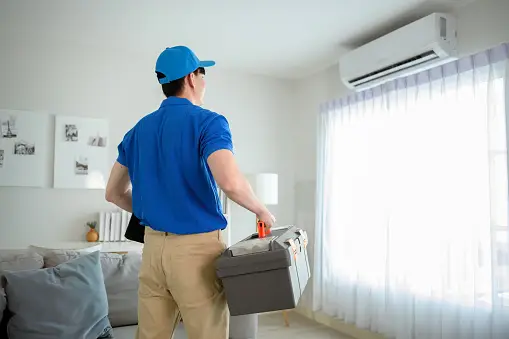As the seasons change and temperatures fluctuate, your HVAC (Heating, Ventilation, and Air Conditioning) system becomes the unsung hero of home comfort. However, like any hero, it faces its share of challenges. In this comprehensive guide, we’ll explore the common HVAC problems that homeowners often encounter and provide practical solutions to keep your system running smoothly throughout the year.
1. The Mysterious Case of Inadequate Heating or Cooling:
Problem: Your HVAC system’s primary function is to maintain a comfortable temperature in your home. If you notice uneven heating or cooling or if the system seems to struggle to reach the set temperature, there might be an issue.
Solution: Several factors can contribute to inadequate heating or cooling. Check and replace air filters regularly, as clogged filters can restrict airflow. Additionally, inspect the thermostat settings, and if needed, recalibrate or replace the thermostat. If the problem persists, it might be indicative of a more complex issue, and professional intervention may be required.
2. The Noisy Ductwork Dilemma:
Problem: Unusual sounds emanating from your HVAC system, such as banging, rattling, or whistling noises, can be disconcerting.
Solution: Noisy ductwork is often a result of loose or unsecured components. Inspect and tighten any loose connections, and check for debris or obstructions within the ducts. If the issue persists, it’s advisable to bring in a professional technician to conduct a thorough inspection.
3. The Leaky Affair of Refrigerant:
Problem: A refrigerant leak can compromise the efficiency of your air conditioning system, leading to reduced cooling performance.
Solution: If you suspect a refrigerant leak, it’s crucial to address it promptly. Refrigerant leaks not only impact efficiency but can also be harmful to the environment. Contact a certified HVAC technician to identify and repair the leak. They will also recharge the refrigerant to ensure optimal performance.
4. The Perennial Pilot Light Predicament:
Problem: For those with gas furnaces, a malfunctioning pilot light can result in no heat production.
Solution: If the pilot light keeps going out, it might be due to issues with the thermocouple or a clogged pilot orifice. Carefully relight the pilot following the manufacturer’s instructions. If the problem persists, or if you notice any irregularities, it’s essential to consult a professional technician to avoid potential safety hazards.
5. The Duct Dilemma:
Problem: Leaky or poorly insulated ducts can result in energy waste, decreased system efficiency, and uneven heating or cooling.
Solution: Inspect your ductwork for any visible leaks or gaps. Seal these using duct tape or mastic sealant. Additionally, ensure that your ducts are adequately insulated, especially in unconditioned spaces like the attic or crawl spaces. Well-maintained ducts contribute to improved energy efficiency and a more even distribution of air throughout your home.
6. The Frozen Evaporator Coil Conundrum:
Problem: A frozen evaporator coil can obstruct airflow, leading to reduced cooling performance.
Solution: Several factors can cause an evaporator coil to freeze, including a dirty air filter, low refrigerant levels, or issues with the blower motor. Begin by replacing the air filter and allowing the coil to thaw. If the problem persists, consult a professional technician to identify and address the root cause.
7. The Thermostat Tango:
Problem: Issues with the thermostat can result in inaccurate temperature readings or erratic system behavior.
Solution: Calibrate your thermostat to ensure accurate temperature readings. Additionally, check for any obstructions around the thermostat that might affect its performance. If you have an older thermostat, upgrading to a programmable or smart thermostat can enhance control and energy efficiency.
8. The Electrical Gremlins:
Problem: Electrical issues, such as frequent tripping of circuit breakers or flickering lights when the HVAC system is in operation, can be a cause for concern.
Solution: Inspect the electrical components of your HVAC system, including wiring and circuit boards, for any signs of damage or wear. If you’re not comfortable doing this yourself, it’s advisable to seek the expertise of a licensed electrician or HVAC technician to address potential safety hazards.
9. The Lingering Odors and Indoor Air Quality Quandary:
Problem: Unpleasant odors emanating from your HVAC system can impact indoor air quality and the overall comfort of your home.
Solution: Addressing this issue involves identifying the source of the odor. It could be due to mold or mildew growth within the system, a clogged air filter, or even issues with the ductwork. Regularly change air filters, schedule professional duct cleanings, and ensure your HVAC system is adequately ventilated to minimize odors and maintain good indoor air quality.
10. The Aging System Ailments:
Problem: As HVAC systems age, they may experience a decline in performance and efficiency.
Solution: Regular maintenance is key to extending the lifespan of your HVAC system. Schedule annual inspections and tune-ups with a qualified technician. They can identify and address minor issues before they escalate, ensuring your system continues to operate at peak efficiency.
Conclusion: A Symphony of Solutions for HVAC Harmony
In the intricate dance of home comfort, addressing common HVAC problems is essential for maintaining a harmonious living environment. From inadequate heating or cooling to electrical gremlins and aging system ailments, each issue requires a tailored solution.
Regular maintenance, prompt identification of problems, and professional intervention when needed are the pillars of a healthy HVAC system. By understanding the nuances of these common problems and implementing proactive solutions, you can ensure that your HVAC system continues to be the reliable conductor of comfort in your home. So, let the symphony of HVAC harmony play on, keeping your home at the perfect temperature year-round.


Oh my goodness! an amazing article dude. Thanks Nonetheless I am experiencing issue with ur rss . Don’t know why Unable to subscribe to it. Is there anyone getting similar rss problem? Anyone who is aware of kindly respond. Thnkx